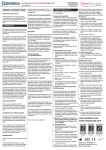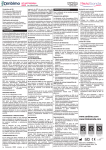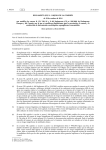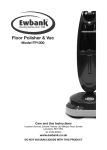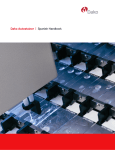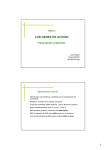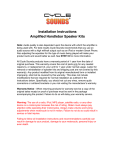Download www.cenbimo.com www.histosonda.com ESPAÑOL
Transcript
Contenidos del Kit KIT HISTOSONDA® ALFA FETOPROTEINA (AFP) Ref: CEM-KIT-0023 20 X Histosonda AFP CEM-0023 20 X Proteinasa K CEM-E-PK 1X 2 X Anti-Digoxina CEM-A-DIG 1X Ensayo para 20 determinaciones individuales presentadas en viales liofilizados Clasificación del producto: Países miembros de la Unión Europea: "Para Utilización en el Diagnóstico In Vitro" Países que no pertenecen a la Unión Europea: "Para Uso Exclusivo en Investigación" INTRODUCCIÓN Alfa Fetoproteina es la proteína sérica más abundante en el feto y muestra una gran similaridad en propiedades físicas con la seroalbúmina. En el adulto la concentración sérica de Alfa fetoproteina es muy baja, salvo cuando el paciente presenta hepatocarcinoma o teteratoma. Los genes que codifican para la AFP y la Seroalbúmina son genes sinténicos y se sitúan en el brazo largo del cromosoma 4. Después del nacimiento el organismo invierte las producciones de AFP que declina rápidamente y aumenta considerablemente la producción de Seroalbúmina. ESPAÑOL for english version see rear side cubierto y de que no quedan burbujas de La sonda marcada, de secuencia conocida, aire. se hibrida con su diana en el tejido problema. Esta unión se detecta mediante un proceso 3. Coloque los cristales en posición inmunohistoquímico. horizontal en una cámara húmeda y cierre bien. La Histosonda AFP consiste en un fragmento Las Histosondas, cuya diana es el RNA de DNA de una única cadena con una mensajero, están destinadas a hacer visibles 4. Incube a 62ºC durante 1 h. longitud de 311 nucleótidos dirigida contra el los genes que se expresan detectando la 5. Si no dispone de una cámara húmeda mRNA de la Alfa Fetoproteina. Este DNA ha expresión génica. apropiada, ponga una gota (65 µl) de sido marcado con Digoxigenina. sonda sobre un cubreobjetos de 24x50 Protocolo de HistoSonda mm y colóquelo sobre el tejido. Selle los CONDICIONES DE ALMACENAMIENTO bordes del cubreobjetos con pegamento. Antes de comenzar, precaliente la cámara Incube en una estufa a 62 º C o en una Los reactivos suministrados se almacenan a húmeda a 62C. placa caliente durante una hora. Después temperatura ambiente hasta la fecha de de la incubación, retire con cuidado el caducidad indicada en su etiqueta. Una vez Reconstitución de la sonda pegamento y el cubreobjetos y continúe reconstituidos, la sonda permanecerá estable 1. Añada 65µl de agua destilada (de buena con el protocolo. 2 semanas a 4ºC en un medio libre de calidad) al vial de Histosonda, dé un DNAasas y la Anti-Digoxina un mes a 4ºC, pequeño vórtex y centrifugue si fuese Lavado de la sonda mientras que la Proteinasa K debe ser necesario. utilizada en el momento de la reconstitución. 1. Lave la superficie del tejido vigorosamente Desparafinación con PBS pH 7.4 para retirar toda la sonda. No utilizar los productos después de la fecha Agite en PBS durante 5mins. 2. 1. Caliente los portaobjetos a 62ºC durante de caducidad indicada en sus etiquetas. 10mins utilizando una placa caliente o un Revelado de la sonda MUESTRAS incubador. 2. Introduzca los portaobjetos en el siguiente Protocolo para el revelado manual de la Cualquier corte de un bloque de parafina en sonda. Como alternativa puede utilizar un orden en: el cual se desee estudiar la presencia de aparato automático de inmunohisoquímica. RNA de la Alfa Fetoproteina. Cortes de 4-6 a. Xileno: 10 mins micrómetros de espesor son adecuados para b. Xileno: 5mins 1. Reconstituya el anticuerpo Anti-Digoxina el estudio. El corte es preferible que sea de Cenbimo con 1 ml de agua destilada. Cada vial es válido para 10 portaobjetos. reciente (no más de treinta días) anque los c. Alcohol absoluto (etanol o isopropanol): 1min X 2 veces resultados del ensayo no se ven afectados 2. Retire el exceso de buffer de los cortes por la antigüedad del bloque. Se han d. Alcohol 96%: 1min X 3 veces como anteriormente. realizado estudios en las instalaciones del e. Metanol con 0.3% H2O2: 5mins Cubra el tejido con 100 µl de Anti-Digoxina 3. fabricante utilizando bloques de parafina de e incube en una cámara húmeda durante 20 años de antigüedad con óptimos 3. Lave enérgicamente los portaobjetos con 30mins a temperatura ambiente. agua (destilada o corriente), manténgalos resultados. en agua 1min. 4. Lave enérgicamente con PBS, y agite en INTERPRETACIÓN PBS pH 7.4 y agite en PBS durante 1min. Inhibición de uniones inespecíficas de DE LOS RESULTADOS DNA (opcional) 5. Retire el exceso de buffer de los cortes. Proteinasa K y 2 tubos del anticuerpo AntiDigoxina válidos para 20 tests. Todos los productos son liofilizados según se indica en la etiqueta. Existen anticuerpos comerciales contra la AFP para el diagnóstico de tumores de esta proteína pero casi siempre producen un gran fondo tisular que imposibilita una correcta Las muestras en las que se observe visión. expresión de Alfa Fetoproteina deberán Histosonda Alfa Fetoproteina es un mostrar una coloración marrón en el fragmento de DNA monocatenario de 311 citoplasma celular que contrastará sobre el nucleótidos de longitud que va dirigido contra fondo azul-violeta que confiere la tinción con el RNA de la AFP. hematoxilina. El facultativo valorará los Su utilidad se centra en el diagnóstico de los resultados en base a su experiencia a partir tumores primitivos del hígado y de los de la visualización de las señales observadas en la muestra, en paralelo con las señales tumores embrionarios de las gónadas. observadas en las muestras de control Hasta el 70% de los hepatocarcinomas son positivo y control negativo. productores de AFP. Su utilización junto con la Histosonda Seroalbumina permite un LIMITACIONES DEL ENSAYO diagnóstico correcto de los tumores El Kit Histosonda AFP ha sido optimizado primitivos de hígado y su diagnóstico para detectar la expresión de Alfa diferencial con tumores metastáticos en el Fetoproteina RNA en tejidos fijados en formol hígado. e incluidos en parafina. No se recomienda la Por lo general este paso no es necesario, a 6. Ponga una gota de un polímero comercial anti-ratón HRP sobre el tejido (suficiente menos que el tejido que vaya a hibridar para cubrir todo el tejido 50-100 µl) e contenga una gran cantidad de leucocitos incube en una cámara húmeda siguiendo polimorfonucleares eosinófilos las instrucciones del fabricante. (generalmente médula ósea y tejidos gástricos). 7. Lave vigorosamente con PBS, agite en PBS durante 1min. 1. Coloque los portaobjetos en 200 ml de agua destilada en un microondas hasta 8. Retire el exceso de buffer de los tejidos y aplique una dilución de Diaminobenzidina que el líquido hierva de manera uniforme (DAB) comercial siguiendo las (normalmente unos 2 min). instrucciones del fabricante. 2. Cambie los portaobjetos inmediatamente 9. Lave con agua. a agua a temperatura ambiente. 3. Como alternativa puede introducir los 10.Tiña los cortes brevemente (2-3secs) con hematoxilina Harris diluída al 50% en portaobjetos en agua destilada hirviendo agua. durante 30 segundos e inmediatamente transfiéralos a agua destilada a 11.Lave con agua, deshidrate y haga el utilización de otro tipo de muestras o de temperatura ambiente. montaje de los cristales siguiendo los técnicas de preparación. protocolos habituales del laboratorio. ¡Importante: un tratamiento térmico excesivo El funcionamiento del kit ha sido validado puede provocar una tinción de fondo. Saque utilizando los protocolos indicados en el los portaobjetos de manera inmediata. manual de instrucciones. La utilización de otros procedimientos o las modificaciones de Desproteinización Los tumores embrionarios de las gónadas y línea media pueden mostrar un importante grado de complejidad y distintos niveles de diferenciación no bien reconocibles con las técnicas histológicas convencionales. La Histosonda Alfa Fetoproteina permite identificar el número y localización de células los protocolos recomendados, productoras de AFP en un corte tisular. conducir a resultados erróneos. pueden 1. Reconstituya la Proteinasa K de Cenbimo con 200µl de agua destilada (1 vial por FINALIDAD PREVISTA cada portaobjetos). Los resultados de este ensayo deben ser evaluados por el facultativo en combinación 2. Retire el exceso de agua de cada Para su uso en diagnóstico in Vitro con el resto de datos clínicos del paciente de portaobjetos con un pañuelo de papel. El Kit Histosonda AFP es útil para el los que se disponga. 3. Cubra el tejido con 200µl de Proteinasa K diagnóstico de los tumores primitivos del e incube en una cámara húmeda hígado y de los tumores embrionarios de las Para la obtención de unos resultados exactamente 10mins a temperatura óptimos y reproducibles es muy importante gónadas. ambiente. ajustarse rigurosamente a las condiciones de tiempos y temperaturas indicadas en el 4. Lave enérgicamente con agua. ADVERTENCIAS Y PRECAUCIONES procedimiento. 5. Introduzca los portaobjetos en PBS pH 7.4 El Kit Histosonda AFP ha sido diseñado para durante 2mins. su utilización en el diagnóstico in vitro para Fecha de emisión: 01/03/2010 (Importante: si los cortes han sido tratados uso profesional y debe ser manipulado por INSTRUCCIONES DE USO previamente con calor en microondas, use la personal cualificado y debidamente entrenado. Para la utilización de las sondas marcadas Proteinasa K sólo durante 5 minutos, ya que este tratamiento sensibiliza mucho los tejidos Para la obtención de unos resultados con Digoxigenina para esta enzima. Las médulas óseas fijadas adecuados, deben seguirse fielmente las PRINCIPIO DEL MÉTODO en ácido fórmico o EDTA requieren una instrucciones del manual. Cualquier cambio digestión de 20 min a 55C con Proteinasa K) en las temperaturas o tiempos indicados, o La Hibridación In Situ Cromogénica (CISH), en cualquier otro paso del proceso, puede es una técnica utilizada para determinar la Incubación con la sonda presencia de una secuencia de ADN o ARN, dar lugar a resultados erróneos. o estudiar la expresión de un gen así como la 1. Retire el exceso de buffer del portaobjetos con un pañuelo de papel. COMPONENTES DEL KIT evaluación simultánea de la morfología del www.cenbimo.com www.histosonda.com Fabricante: CENBIMO S.L. El Kit incluye 20 tubos monotest de la tejido mediante el uso de microscopía de 2. Añada los 65 µl de la sonda al corte C/ Doctor Iglesias Otero, s/n asegurándose de que todo el tejido queda 27004 Lugo, Spain Histosonda AFP; 20 tubos monotest de la campo claro. Kit Contents KIT HISTOSONDA® ALPHA FETAL PROTEIN (AFP) Ref: CEM-KIT-0023 20 X Histosonda AFP CEM-0023 20 X Proteinase K CEM-E-PK 1X 2 X Anti-Digoxin CEM-A-DIG 1X Assay for 20 individual reactions in lyophilized vials. Product classification: EU countries: "For In Vitro Diagnostics" Non- EU countries: "For Research Use Only" INTRODUCTION Alpha Fetal Protein is the most abundant seric protein in the fetus which demonstrates great similarity to the physical properties of serum albumin. In the adult, the seric concentration of AFP is very low, apart from when the patient presents with a hepatocarcinoma or teteratoma. The genes that code for AFP and serum albumin are syntenic genes that are situated on the long arm of chromosome 4. After birth the organism inverts the production of AFP so that it declines rapidly and also considerably increases the production of serum albumin. There are commercial antibodies against AFP for the diagnosis of tumors that produce this protein but they almost always produce so much tissue background that a clear view becomes impossible. Histosonda Alpha Fetoprotein is a single stranded DNA fragment of 311 nucleotides that is targeted against the RNA of AFP. Its use is centered on the diagnosis of primitive liver tumors and embryonic tumors of the gonads. Up to 70% of hepatocarcinomas are producers of AFP. The use of this probe combined with Histosonda Serum Albumin permits a correct diagnosis of primitive liver tumors and their differencial diagnosis with metastatic tumors in the liver. STORAGE CONDITIONS Supplied reagents are stored at room temperature until their expiration date. After being reconstituted the probes will remain stable for two weeks at 4ºC in a DNAase-free environment. The Anti-Digoxin can be stored at 4ºC for 1 month and the Proteinase K must be used immediately and cannot be stored. Do not use these products after their expiration dates. PROCEDURE ENGLISH versión en español ver dorso For Digoxigenin- labeled probes 4. Incubation with the probe 1. Remove excess buffer from sections as described previously. BASIS OF THE METHOD 2. Add the 65µl of probe to the tissue section ensuring the entire section is completely Chromogenic In Situ Hybridization (CISH) is covered and avoiding air bubbles. a technique used to determine the presence of a DNA or RNA sequence or to study gene 3. Place the slides in a horizontal position in a humid chamber and close well. expression, as well as for the simultaneous evaluation of tissue morphology by white light 4. Incubate at 62ºC for 1hr. microscopy. A labeled probe of known SAMPLES sequence hybridizes with its target in the 5. If no suitable humid chamber is available drop the 65µl of probe over a 24 X 50 mm tissue being studied. This hybridization is coverslip and place over the tissue Any paraffin block section in which Alpha then detected by an immunohistochemical section. Seal the edges of the coverslip Fetal Protein RNA presence is to be studied. process. with rubber cement. Incubate in a 62ºC Sections of 4-6 micrometers in width are incubator or over a hot plate for 1 hour. sufficient to conduct the study. Preferably, the The Histosondas targets are messenger RNA After incubation carefully remove the cut should be recent (no more than thirty and they are therefore designed to detect and rubber cement and coverslip and continue days old). visualise gene expression. the protocol. Assay results are not affected by block age. HistoSonda Protocol 5. Washing the probe Studies have been carried out in the Before starting pre-heat the humid chamber 1. Wash the surface of the section vigorously manufacturersʼ laboratories using 20 year old to 62ºC. with PBS pH 7.4 to remove the probe. paraffin blocks with optimal results. 1. Reconstitute the probe 2. Agitate in PBS for 5mins. INTERPRETATION OF RESULTS 1. Add 65µl of (good quality) distilled water to Samples in which Alpha Fetal Protein the HistoSonda tube, briefly vortex and 6. Revealing the probe expression is observed will show a brownish centrifuge if possible. Protocol for manual revealing of the probe. color in the cell cytoplasm, which will contrast 2. Deparaffinization Alternatively, an automatic immunohistoover the blue-violet background given by hematoxylin staining. The pathologist will 1. Heat slides at 62ºC for 10mins using a hot chemistry apparatus may be used. evaluate the results according to their plate or incubator. 1. Reconstitute Anti-Digoxin from Cenbimo experience, drawing conclusions from the 2. Immerse slides in: with 1ml of distilled water. Each vial is staining of the sample in parallel with the valid for 10 slides. staining observed in positive and negative a. Xylene: 10 mins controls. 2. Remove excess buffer from sections as b. Xylene: 5mins before. c. Absolute alcohol (ethanol or isopropanol): ASSAY LIMITATIONS 3. Cover sections with 100µl of Anti-Digoxin 1min X 2 and incubate in a humid chamber for The Kit Histosonda AFP has been optimized d. Alcohol 96%: 1min X 3 30mins at room temp. to detect Alpha Fetal Protein RNA expression in formalin-fixed, paraffin-embedded tissues. e. Methanol containing 0.3% H2O2 or 3% 4. Wash vigorously with PBS, pH 7.4 agitate H2O2 only :5mins Its use is not recommended for other types of in PBS for 1min. samples or preparation techniques. 3. Wash well with distilled water, leave 5. Remove excess buffer from sections. standing in water. The correct operation of this kit has been 6. Drop commercial polymer anti-mouse validated using the protocols indicated in the 2b. Inhibition of unspecific DNA binding HRP over the sections (enough to cover instructions manual. The use of other (optional) the tissue 50-100µl) incubate in a humid procedures or the modification of the Generally this step is not necessary unless chamber following the manufacturerʼs recommended protocols may lead to the tissue to be hybridized contains a great instructions. erroneous results. quantity of polymorphonuclear eosinophil 7. Wash vigorously with PBS, agitate in PBS 1min. The results from this assay must be leukocytes (generally bone marrow and evaluated by the pathologist in combination gastric tissues). 8. Remove excess buffer from sections and with the rest of available patient clinical data. 1. Place slides in 200ml distilled water in a apply commercial Diaminobenzidine (DAB) following the manufacturerʼs microwave until the liquid boils uniformly In order to obtain optimal and reproducible instructions. (normally around 2mins). results it is important to rigorously maintain The embryonic tumors of the gonads and midline can show an important degree of complexity and distinct levels of differentiation not well recognisable with conventional histological techniques. Histosonda Alpha Fetal Protein permits the identification of the the time and temperature conditions indicated 2. Immediately transfer slides to distilled 9. Wash with water. water at room temperature. 10.Counter stain the sections briefly (2number and localization of cells producing in the procedure. 3secs) with Harris hematoxylin diluted AFP in a tissue section. 3. Alternatively place slides in boiling distilled 50% in water. water for 30 seconds and immediately INTENDED USE transfer to distilled water at room temp. 11.Wash with water, dehydrate and cover slip following normal laboratory protocols. For use in In Vitro Diagnosis. ! Important: excess heat treatment will result Emission date: 01/03/2010 in background staining. Remove slides The Kit Histosonda AFP is useful for the immediately. ! diagnosis of primitive liver tumors and embryonic tumors of the gonads. 3. Deproteinization WARNINGS AND PRECAUTIONS The Kit Histosonda AFP has been designed for professional use in In Vitro Diagnosis and must be manipulated by qualified and accordingly trained personnel. In order to obtain the best results, the instructions contained in the manual must be followed. Any change to the indicated temperatures, times or any other step of the process can lead to poor results. KIT COMPONENTS The Kit includes 20 single test tubes of Histosonda AFP; 20 single test tubes of Proteinase K and 2 tubes of Anti-Digoxin antibody sufficient for 20 tests in total. All products are lyophilized. Histosonda AFP consists of a single stranded DNA fragment with a length of 311 nucleotides targeted against Alpha Fetal Protein mRNA. The DNA of this probe has been labeled with digoxigenin. 1. Reconstitute Proteinase K from Cenbimo with 200µl of distilled water (1 vial for each slide). 2. Remove excess water from individual slides with tissue paper. 3. Cover tissue sections with the 200 µl of Proteinase K and incubate in a humid chamber for exactly 10mins at room temp. www.cenbimo.com www.histosonda.com 4. Wash well with water. 5. Transfer to PBS pH 7.4 for 2mins. ! (Important: if the slides have been boiled in the microwave previously only use Proteinase K for 5 minutes as the heat treatment will have significantly sensitized the tissue sections. For bone marrows continue to use 10mins after heat treatment. Bone marrows fixed in formic acid or EDTA require a Proteinase K digestion of 20min at 55ºC.) ! Fabricante: CENBIMO S.L. C/ Doctor Iglesias Otero, s/n 27004 Lugo, Spain


